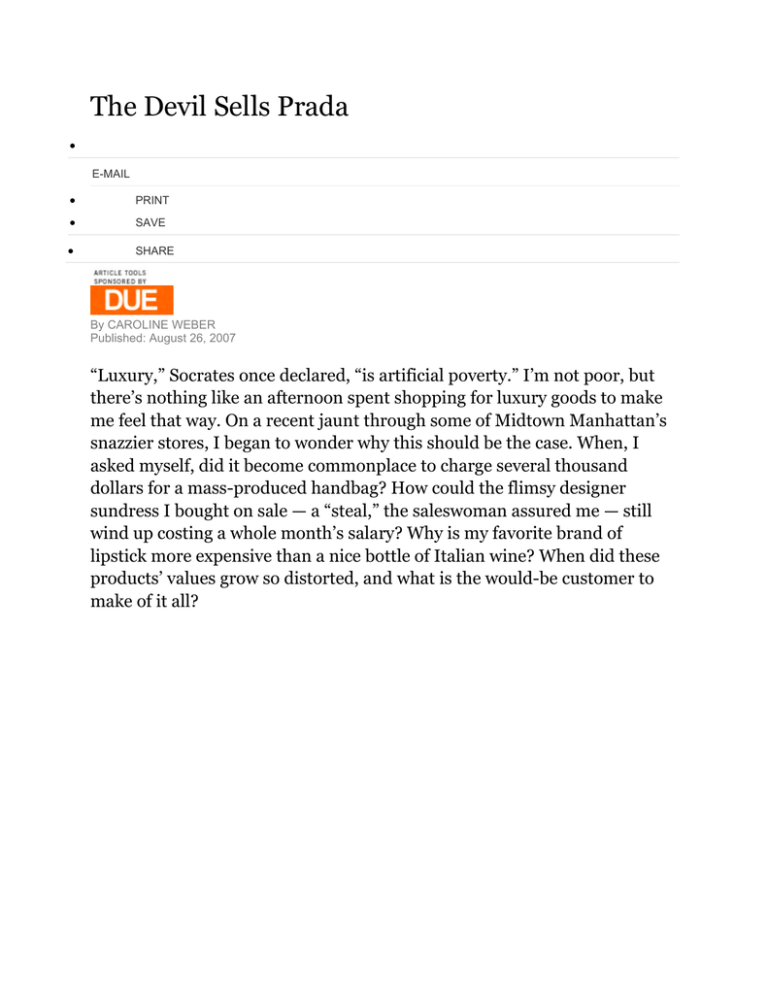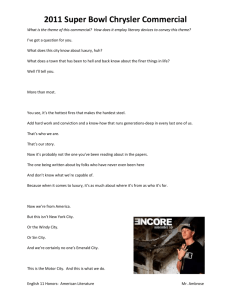The Devil Sells Prada
advertisement

The Devil Sells Prada • E-MAIL • PRINT • SAVE • SHARE By CAROLINE WEBER Published: August 26, 2007 “Luxury,” Socrates once declared, “is artificial poverty.” I’m not poor, but there’s nothing like an afternoon spent shopping for luxury goods to make me feel that way. On a recent jaunt through some of Midtown Manhattan’s snazzier stores, I began to wonder why this should be the case. When, I asked myself, did it become commonplace to charge several thousand dollars for a mass-produced handbag? How could the flimsy designer sundress I bought on sale — a “steal,” the saleswoman assured me — still wind up costing a whole month’s salary? Why is my favorite brand of lipstick more expensive than a nice bottle of Italian wine? When did these products’ values grow so distorted, and what is the would-be customer to make of it all? How Luxury Lost Its Luster. By Dana Thomas. Illustrated. 375 pp. The Penguin Press. $27.95. In the midst of my consumerist crisis, the question I should have been asking was: Dana Thomas, where have you been all my life? In “Deluxe: How Luxury Lost Its Luster,” Thomas investigates the business of designer clothing, leather goods and cosmetics, and finds it wanting. Hijacked, over the past two or three decades, by corporate profiteers with a “single-minded focus on profitability,” the luxury industry has “sacrificed its integrity, undermined its products, tarnished its history and hoodwinked its consumers.” Hoodwinked? The truth hurts. After I read “Deluxe,” suddenly my new sundress no longer looked like such a steal. Au contraire, the book’s line of argument suggested, it was I who’d been robbed. For Thomas, a cultural and fashion writer for Newsweek in Paris and the Paris correspondent for the Australian Harper’s Bazaar, the luxury industry is a sham because its offerings in no way merit the high price tags they command. Yet once upon a time, they most certainly did. In the 19th and early 20th centuries, when many of luxury’s founding fathers first set up shop, paying more money meant getting something truly exceptional. Dresses from Christian Dior, luggage from Louis Vuitton, jewelry from Cartier: in the golden period of luxury, these items carried prestige because of their superior craftsmanship and design. True, only the very privileged could afford them, but it was this exclusivity that gave them their cachet. Although they may have “cared about making a profit,” the merchants who served this pampered class aimed chiefly “to produce the finest products possible.” All that changed, however, in the last decades of the 20th century, when a new breed of luxury purveyor, epitomized by Bernard Arnault, now the chairman and chief executive of the multibillion-dollar LVMH Moët Hennessy Louis Vuitton conglomerate, first came on the scene. “A businessman, not a fashion person,” Arnault realized that the mystique of the great brand names represented an invaluable — and historically underexploited — asset. Identifying the luxury sector as “the only area in which it is possible to make luxury margins,” Arnault snapped up Dior, Vuitton and a clutch of other star brands. Then, by spending hundreds of millions on advertising, dressing celebrities for the red carpet, “splashing the logo on everything from handbags to bikinis,” and pushing product in duty-free stores and flagship boutiques all around the world, he turned these brands into objects of global consumer desire. In so doing, Arnault changed “the course of luxury forever.” And strictly, Thomas argues, for the worse. Insofar as luxury has gone corporate, relentlessly focused on the bottom line, quality has disappeared. In order to keep margins high (in 2005, LVMH recorded more than $17 billion in sales and a net profit of almost $1.8 billion), Arnault and his competitors have cut costs wherever and whenever possible. The most obvious strategies involve using cheaper materials, replacing skilled artisans with computers and machines and outsourcing labor to less expensive markets like China. Sneakier tactics include “cutting sleeves a half an inch shorter” (“when you get to 1,000, you see the savings,” one employee told the author), replacing finished seams with raw edges and eliminating linings on the grounds that “women don’t really need” them. A grouchy aside: my aforementioned sundress is (a) an LVMH brand and (b) unlined. It is also (c) white, which means that a lining would sure have come in handy. But if Arnault can amass a personal fortune of more than $21 billion by forcing me to display my underwear, then who am I to complain? In truth, the perverse reality of luxury consumption today is that so few people are complaining, and so many are clamoring for what Thomas refers to (a bit too frequently for my taste) as a piece of the “dream.” Paradoxically, as craftsmanship has waned, consumer appetite has grown — and not just among luxury’s original, elite clientele. The vast reach of contemporary advertising, distribution and product-placement efforts has effectively democratized luxury, making once exclusive brands available, if only in the form of logo-covered sneakers or sunglasses, to middle-market customers the world over. “Luxury-brand logos convey wealth, status and chic,” Thomas explains, “even if the bearer of the logo-ed product is a middle-market suburban housewife who bought it on credit.” As a result, a designer jacket or handbag or watch no longer transmits reliable information about its wearer’s socioeconomic stature or background. Without quite coming right out and saying it, Thomas seems nostalgic for the good old days when “a middle-market suburban housewife,” say, couldn’t be confused with her betters. The author is shocked to overhear a woman “in a designer pantsuit, good jewelry and Chanel sunglasses” expressing interest in a fake Rolex. Spotting a couple loading shopping bags into a $380,000 car, she is surprised to learn that their loot came from an outlet store. In a discussion of the booming, underground market for counterfeit luxury goods, she compares “folks with a craving for the goods but not enough dough for the genuine thing” to petty teenage drug users — eager “to buy a couple of joints with their allowance or baby-sitting money.” She quotes a commentator on the last days of the Roman Republic, who contrasts an era of rampant, nouveauriche acquisitiveness to an earlier and more “patrician” age when “people used to know their place.” These hints of condescension are regrettable, for Thomas’s message is relevant to shoppers of every stripe. Whether upscale or middle-market, paying in cash or buying on credit, today’s customer is barraged at every turn with the logos that, for titans like Arnault, mean pure, corporate gold. “Deluxe” performs a valuable service by reminding us that these labels don’t mean much else. Once guarantors of value and integrity, they are now markers that point toward nothing, guiding the consumer on a road to nowhere.





